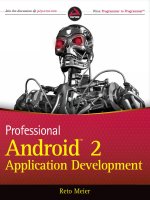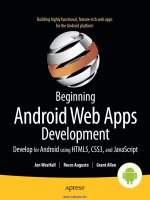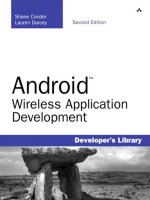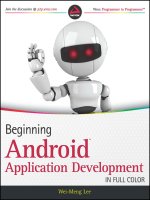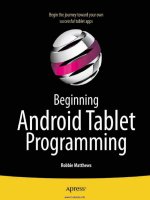1067 beginning android tablet application development
Bạn đang xem bản rút gọn của tài liệu. Xem và tải ngay bản đầy đủ của tài liệu tại đây (18.19 MB, 290 trang )
www.it-ebooks.info
www.it-ebooks.info
ffirs.indd ii
28/06/11 2:58 PM
BEGINNING
ANDROID™ TABLET APPLICATION DEVELOPMENT
INTRODUCTION . . . . . . . . . . . . . . . . . . . . . . . . . . . . . . . . . . . . . . . . . . . . . . . . . . . . . . . . . . . . . xiii
PART I
QUICK TOUR OF ANDROID 3 FOR TABLETS
CHAPTER 1
Getting Started with Android Programming for Tablets . . . . . . . . . . . . . . 3
CHAPTER 2
Components of an Android Tablet Application . . . . . . . . . . . . . . . . . . . . 29
CHAPTER 3
Android User Interface . . . . . . . . . . . . . . . . . . . . . . . . . . . . . . . . . . . . . . . . . 65
PART II
PROJECTS
CHAPTER 4
Creating Location-Based Services Applications . . . . . . . . . . . . . . . . . . 109
CHAPTER 5
SMS Messaging and Networking . . . . . . . . . . . . . . . . . . . . . . . . . . . . . . . . 151
CHAPTER 6
Publishing Android Applications . . . . . . . . . . . . . . . . . . . . . . . . . . . . . . . . 205
PART III
APPENDICES
APPENDIX A
Using Eclipse for Android Development . . . . . . . . . . . . . . . . . . . . . . . . . 229
APPENDIX B
Using the Android Emulator . . . . . . . . . . . . . . . . . . . . . . . . . . . . . . . . . . . . 243
APPENDIX C
Answers to Exercises . . . . . . . . . . . . . . . . . . . . . . . . . . . . . . . . . . . . . . . . . 259
INDEX . . . . . . . . . . . . . . . . . . . . . . . . . . . . . . . . . . . . . . . . . . . . . . . . . . . . . . . . . . . . . . . . . . . . . 263
www.it-ebooks.info
ffirs.indd i
28/06/11 2:58 PM
www.it-ebooks.info
ffirs.indd ii
28/06/11 2:58 PM
BEGINNING
Android™ Tablet Application Development
Wei-Meng Lee
www.it-ebooks.info
ffirs.indd iii
28/06/11 2:58 PM
Beginning Android™ Tablet Application Development
Published by
Wiley Publishing, Inc.
10475 Crosspoint Boulevard
Indianapolis, IN 46256
www.wiley.com
Copyright © 2011 by Wiley Publishing, Inc., Indianapolis, Indiana
Published simultaneously in Canada
ISBN: 978-1-118-10673-0
ISBN: 978-1-118-15075-7 (ebk)
ISBN: 978-1-118-15077-1 (ebk)
ISBN: 978-1-118-15076-4 (ebk)
Manufactured in the United States of America
10 9 8 7 6 5 4 3 2 1
No part of this publication may be reproduced, stored in a retrieval system or transmitted in any form or by any means,
electronic, mechanical, photocopying, recording, scanning or otherwise, except as permitted under Sections 107 or 108
of the 1976 United States Copyright Act, without either the prior written permission of the Publisher, or authorization
through payment of the appropriate per-copy fee to the Copyright Clearance Center, 222 Rosewood Drive, Danvers,
MA 01923, (978) 750-8400, fax (978) 646-8600. Requests to the Publisher for permission should be addressed to
the Permissions Department, John Wiley & Sons, Inc., 111 River Street, Hoboken, NJ 07030, (201) 748-6011,
fax (201) 748-6008, or online at />Limit of Liability/Disclaimer of Warranty: The publisher and the author make no representations or warranties with
respect to the accuracy or completeness of the contents of this work and specifically disclaim all warranties, including
without limitation warranties of fitness for a particular purpose. No warranty may be created or extended by sales or
promotional materials. The advice and strategies contained herein may not be suitable for every situation. This work
is sold with the understanding that the publisher is not engaged in rendering legal, accounting, or other professional
services. If professional assistance is required, the services of a competent professional person should be sought. Neither
the publisher nor the author shall be liable for damages arising herefrom. The fact that an organization or Web site is
referred to in this work as a citation and/or a potential source of further information does not mean that the author or the
publisher endorses the information the organization or Web site may provide or recommendations it may make. Further,
readers should be aware that Internet Web sites listed in this work may have changed or disappeared between when this
work was written and when it is read.
For general information on our other products and services please contact our Customer Care Department within the
United States at (877) 762-2974, outside the United States at (317) 572-3993 or fax (317) 572-4002.
Wiley also publishes its books in a variety of electronic formats and by print-on-demand. Not all content that is available in
standard print versions of this book may appear or be packaged in all book formats. If you have purchased a version of this
book that did not include media that is referenced by or accompanies a standard print version, you may request this media by
visiting . For more information about Wiley products, visit us at www.wiley.com.
Library of Congress Control Number: 2011930129
Trademarks: Wiley, the Wiley logo, Wrox, the Wrox logo, Wrox Programmer to Programmer, and related trade dress are
trademarks or registered trademarks of John Wiley & Sons, Inc. and/or its affiliates, in the United States and other countries,
and may not be used without written permission. Android is a trademark of Google, Inc. All other trademarks are the property
of their respective owners. Wiley Publishing, Inc., is not associated with any product or vendor mentioned in this book.
www.it-ebooks.info
ffirs.indd iv
28/06/11 2:59 PM
To my family:
Thanks for the understanding and support while I
worked on getting this book ready. I love you all!
www.it-ebooks.info
ffirs.indd v
28/06/11 2:59 PM
CREDITS
EXECUTIVE EDITOR
PRODUCTION MANAGER
Bob Elliott
Tim Tate
SENIOR PROJECT EDITOR
VICE PRESIDENT AND EXECUTIVE GROUP
PUBLISHER
Ami Frank Sullivan
Richard Swadley
TECHNICAL EDITOR
VICE PRESIDENT AND EXECUTIVE PUBLISHER
Kunal Mittal
Neil Edde
PRODUCTION EDITOR
ASSOCIATE PUBLISHER
Rebecca Anderson
Jim Minatel
COPY EDITOR
PROJECT COORDINATOR, COVER
Luann Rouff
Katie Crocker
EDITORIAL MANAGER
PROOFREADER
Mary Beth Wakefield
Nancy Carrasco
FREELANCER EDITORIAL MANAGER
INDEXER
Rosemarie Graham
Johnna VanHoose Dinse
ASSOCIATE DIRECTOR OF MARKETING
COVER DESIGNER
Ashley Zurcher
Ryan Sneed
BUSINESS MANAGER
COVER IMAGE
Amy Knies
© Dmitry Mordvintsev/iStockPhoto
www.it-ebooks.info
ffirs.indd vi
28/06/11 2:59 PM
ABOUT THE AUTHOR
WEI-MENG LEE is a technologist and founder of Developer Learning Solutions (www.learn2develop
.net), a technology company specializing in hands-on training on the latest mobile technologies.
Wei-Meng has many years of training experience and his training courses place special emphasis
on the learning-by-doing approach. This hands-on approach to learning programming makes
understanding the subject much easier than reading books, tutorials, and other documentation.
Wei-Meng is also the author of Beginning iOS 4 Application Development (Wrox, 2010) and
Beginning Android Application Development (Wrox, 2011). Contact Wei-Meng at
ABOUT THE TECHNICAL EDITOR
KUNAL MITTAL serves as an Executive Director of Technology at Sony Pictures Entertainment
where he is responsible for the SOA, Identity Management, and Content Management programs.
Kunal is an entrepreneur who helps startups defi ne their technology strategy, product roadmap,
and development plans. He generally works in an Advisor or Consulting CTO capacity, and serves
actively in the Project Management and Technical Architect functions.
He has authored and edited several books and articles on J2EE, Cloud Computing, and mobile
technologies. He holds a Master’s degree in Software Engineering and is an instrument-rated
private pilot.
www.it-ebooks.info
ffirs.indd vii
28/06/11 2:59 PM
ACKNOWLEDGMENTS
WRITING THIS BOOK HAS BEEN A roller-coaster ride. Working with just-released software is always
a huge challenge. When I fi rst started work on this book, the Android 3.0 SDK had just been
released, and wading through the documentation was like fi nding a needle in a haystack. To add
to the challenge, the Android emulator for the tablet is extremely slow and unstable, making the
development process very slow and painful.
Well, now that the book is done, I hope your journey will not be as eventful as mine. Like a good
guide, my duty is to make your foray into Android tablet development an enjoyable and fruitful
experience. The book you are now holding is the result of the collaborative efforts of many people,
and I wish to take this opportunity to acknowledge them here.
First, my personal gratitude to Bob Elliott, executive editor at Wrox. Bob is always ready to lend a
listening ear and to offer help when it’s needed. It is a great pleasure to work with Bob, as he is one
of the most responsive persons I have ever worked with! Thank you, Bob, for the help and guidance!
Of course, I cannot forget Ami Sullivan, my editor (and friend!), who is always a pleasure to work
with. After working together on four books, we now know each other so well that we know the
content of incoming e-mail messages even before we open them! Thank-you, Ami!
Nor can I forget the heroes behind the scenes: copy editor Luann Rouff and technical editor
Kunal Mittal. They have been eagle-eye editing the book, making sure that every sentence makes
sense — both grammatically as well as technically. Thanks, Luann and Kunal!
Last, but not least, I want to thank my parents and my wife, Sze Wa, for all the support they have
given me. They have selflessly adjusted their schedules to accommodate my busy schedule when
I was working on this book. My wife, as always, has stayed up with me on numerous nights as I
was furiously working to meet the deadlines, and for this I would like to say to her and my parents:
“I love you all!” Finally, to our lovely dog, Ookii, thanks for staying by our side.
www.it-ebooks.info
ffirs.indd viii
28/06/11 2:59 PM
CONTENTS
INTRODUCTION
xiii
PART I: QUICK TOUR OF ANDROID 3 FOR TABLETS
CHAPTER 1: GETTING STARTED WITH ANDROID
PROGRAMMING FOR TABLETS
What Is Android?
3
4
Android Versions
Android Devices in the Market
The Android Market
4
6
7
Obtaining the Required Tools
7
Java JDK
Eclipse
Downloading the Android SDK
Installing the Packages
Creating Android Virtual Devices (AVDs)
Android Development Tools (ADT)
Creating Your First Android Application
Anatomy of an Android Application
Summary
CHAPTER 2: COMPONENTS OF AN ANDROID TABLET APPLICATION
Activities
Fragments
7
8
8
9
11
14
17
24
27
29
29
36
Adding Fragments Dynamically
Understanding the Life Cycle of a Fragment
Interactions between Fragments
Utilizing the Action Bar
41
44
48
52
Adding Action Items to the Action Bar
Customizing the Action Items and Application Icon
Summary
54
59
62
CHAPTER 3: ANDROID USER INTERFACE
Views and ViewGroups
65
65
LinearLayout
AbsoluteLayout
66
70
www.it-ebooks.info
toc.indd ix
28/06/11 1:45 PM
CONTENTS
TableLayout
RelativeLayout
FrameLayout
ScrollView
72
74
76
79
Basic Views
81
TextView View
Common Views
81
82
Fragments
91
ListFragment
DialogFragment
PreferenceFragment
91
95
99
Summary
104
PART II: PROJECTS
CHAPTER 4: CREATING LOCATION-BASED SERVICES APPLICATIONS 109
Displaying Maps
109
Creating the Project
Obtaining the Maps API Key
Displaying the Map
Displaying the Zoom Control
Changing Views
Navigating to a Specific Location
Adding Markers
Getting the Location That Was Touched
Geocoding and Reverse Geocoding
Getting Location Data
Summary
110
111
113
120
122
124
127
130
132
135
147
CHAPTER 5: SMS MESSAGING AND NETWORKING
SMS Messaging
151
152
Sending SMS Messages Programmatically
Getting Feedback after Sending the Message
Sending SMS Messages Using Intent
Receiving SMS Messages
Caveats and Warnings
Project: Building the Location Tracker Applications
Sending E-Mail
Networking
152
156
158
159
170
171
185
187
Downloading Binary Data
190
x
www.it-ebooks.info
toc.indd x
28/06/11 1:45 PM
CONTENTS
Downloading Text Files
Accessing Web Services Using the GET Method
Performing Asynchronous Calls
Summary
193
195
200
201
CHAPTER 6: PUBLISHING ANDROID APPLICATIONS
Preparing for Publishing
205
205
Versioning
Digitally Signing Your Android Applications
Deploying APK Files
206
208
213
Using the adb.exe Tool
Using a Web Server
Publishing on the Android Market
Summary
213
215
217
223
PART III: APPENDICES
APPENDIX A: USING ECLIPSE FOR ANDROID DEVELOPMENT
Getting Around in Eclipse
229
229
Workspaces
Package Explorer
Using Projects from Other Workspaces
Editors
Perspectives
Auto Import of Namespaces
Code Completion
Refactoring
Debugging
229
231
232
233
236
236
237
237
238
Setting Breakpoints
Exceptions
239
241
APPENDIX B: USING THE ANDROID EMULATOR
243
Uses of the Android Emulator
Creating Snapshots
Installing Custom AVDs
Emulating Real Devices
SD Card Emulation
Emulating Devices with Different Screen Sizes
Emulating Physical Capabilities
Sending SMS Messages to the Emulator
243
245
246
247
249
250
250
253
xi
www.it-ebooks.info
toc.indd xi
28/06/11 1:45 PM
CONTENTS
Making Phone Calls
Transferring Files into and out of the Emulator
Resetting the Emulator
255
256
258
APPENDIX C: ANSWERS TO EXERCISES
259
INDEX
263
xii
www.it-ebooks.info
toc.indd xii
28/06/11 1:45 PM
INTRODUCTION
I FIRST STARTED PLAYING WITH THE ANDROID SDK before it was officially released as a 1.0 release.
Back then, the tools were unpolished, the APIs in the SDK were unstable, and the documentation
was sparse. Fast forward two and a half years, Android is now a formidable mobile operating
system, with a following no less impressive that the iPhone. Having gone through all the growing
pains of Android, I think now is the best time to start learning about Android programming —
the APIs have stabilized and the tools have improved. But one thing remains: Getting started is
still an elusive goal for many. What’s more, Google has recently released their latest version of
the Android SDK — 3.0, for tablet development. The Android 3.0 SDK comes with several new
features for tablet developers, and understanding all these new features requires some effort on
the part of beginners. It was with this mission in mind that I was motivated to write a book that
beginning Android tablet programmers could appreciate, and one that would enable them to write
progressively sophisticated applications.
This book was written to help jump-start beginning Android developers, in particular developers
targeting tablet devices. It covers just enough for you to get started with tablet programming using
Android. You will learn the basics of the new features in Android 3.0. For a more comprehensive
overview of the various programming capabilities of Android, I suggest you look at my other book,
Beginning Android Application Development (Wrox, 2011).
To make the learning interesting, this book walks through the process of building two projects.
The fi rst project shows how to build a mapping application for your Android tablet. You will
be able to monitor your current location using the built-in GPS, cellular, and wireless network
connections. In addition, you will be able to view your location using the Google Maps. The second
project demonstrates how to build a pair of location tracker applications, allowing you to track
the geographical locations of other Android users through the use of SMS messaging. These two
projects serve as a solid starting point for building real-life tablet applications. Have fun!
WHO THIS BOOK IS FOR
This book is for the beginning Android tablet developer who wants to start developing tablet
applications using the Google’s Android 3.0 SDK. To truly benefit from this book, you should
have some background in programming and at least be familiar with object-oriented programming
concepts. If you are totally new to Java — the language used for Android development — you might
want to take a programming course in Java programming fi rst, or grab one of many good books on
Java programming. In my experience, if you already know C# or VB.NET, learning Java is not too
much of an effort; you should be comfortable just following along with the Try It Out exercises.
For those totally new to programming, I know the lure of developing mobile apps and making some
money is simply too tempting to miss. However, I think a better starting point is learning the basics
of programming before attempting to try out the examples in this book.
www.it-ebooks.info
Flast.indd xiii
28/06/11 1:41 PM
INTRODUCTION
NOTE All the examples discussed in this book were written and tested using
version 2.x and 3.0 of the Android SDK. While every effort has been made to
ensure that all the tools used in this book are the latest, it is likely that by the
time you read this, a newer version of the tools may be available. As such, some
of the instructions/screenshots may differ slightly. However, any changes should
be minimal and you should not have any problems following along.
WHAT THIS BOOK COVERS
This book covers the fundamentals of Android programming using the Android SDK. It is divided
into six chapters and three appendices.
Chapter 1: Getting Started with Android Programming for Tablets covers the basics of the Android
OS and its current state. You will learn about the features of Android devices, as well as some of
the popular devices on the market. You will then learn how to download all the required tools to
develop Android applications and then test them on the various types of Android emulators.
Chapter 2: Components of an Android Tablet Application covers the various parts that make up an
Android tablet application and some of the new features in Android 3.0 that are specifically designed
for tablet applications. In particular, you will learn about the fragment and Action Bar APIs new in
Android 3.0, and how you can make use of them to develop compelling tablet applications.
Chapter 3: Android User Interface covers the various components that make up the UI of an Android
application. You will learn about the different layouts you can use to build the UI of your application,
and the numerous events that are associated with the UI when users interact with the application.
You will also learn about the specialized fragments available for Android tablet applications.
Chapter 4: Creating Location-Based Services Applications shows how to make use of Google Maps in
your Android application, and how to manipulate it programmatically. In addition, you will learn how
to obtain your geographical location using the LocationManager class available in the Android SDK.
By the end of the chapter, you will have created a very cool Android tablet mapping project.
Chapter 5: SMS Messaging and Networking demonstrates how to send and receive SMS messages
programmatically from within your Android application. You will also learn how to use the HTTP
protocol to talk to web servers so that you can download text and binary data. The last part of
this chapter shows you how to parse XML fi les to extract the relevant parts of an XML fi le — a
technique that is useful if you are accessing Web services. By the end of this chapter, you will have
built a functional location tracker application!
Chapter 6: Publishing Android Applications discusses the various ways you can publish your
Android applications when you are ready. You will also learn about the steps to publishing and
selling your applications on the Android Market.
Appendix A: Using Eclipse for Android Development provides a quick run-through of the many
features in Eclipse.
Appendix B: Using the Android Emulator provides tips and tricks on using the Android emulator to
test your applications.
xiv
www.it-ebooks.info
Flast.indd xiv
28/06/11 1:41 PM
INTRODUCTION
Appendix C: Answers to Exercises contains the solutions to the end-of-chapter exercises found in
every chapter.
HOW THIS BOOK IS STRUCTURED
This book breaks down the task of learning Android programming into several smaller chunks,
enabling you to digest each topic before delving into a more advanced one.
If you are a total beginner to Android programming, start with Chapter 1. Once you are
comfortable with the basics here, head on to the appendices to read more about Eclipse and the
Android emulator. When you are ready, you can continue with Chapter 2 and gradually move into
more advanced concepts.
A key feature of this book is that all the code samples in each chapter are independent of those
discussed in previous chapters. This gives you the flexibility to dive into the topics that interest you
most and start working on the Try It Out projects.
WHAT YOU NEED TO USE THIS BOOK
All the examples in this book run on the Android emulator (which is included with the Android
SDK). However, to get the most out of this book, having a real Android device would be optimal
(though not absolutely necessary).
CONVENTIONS
To help you get the most from the text and keep track of what’s happening, we’ve used a number of
conventions throughout the book.
TRY IT OUT
These Are Exercises or Examples for You to Follow
The Try It Out exercises appear once or more per chapter as exercises to work through as you follow
the text in the book.
1.
2.
They usually consist of a set of numbered steps.
Follow the steps through with your copy of the project files.
How It Works
After each Try It Out, the code you’ve typed is explained in detail.
As for other conventions in the text:
➤
New terms and important words are highlighted in italics when first introduced.
➤
Keyboard combinations are treated like this: Control+R.
➤
Filenames, URLs, and code within the text are treated like so: persistence.properties.
xv
www.it-ebooks.info
Flast.indd xv
28/06/11 1:41 PM
INTRODUCTION
Code is presented in two different ways:
We use a monofont type with no highlighting for most code examples.
We use bold to emphasize code that is of particular importance in the
present context.
WARNING Boxes like this one hold important, not-to-be forgotten information
that is directly relevant to the surrounding text.
NOTE Notes, tips, hints, tricks, and asides to the current discussion look
like this.
SOURCE CODE
As you work through the examples in this book, you may choose either to type in all the code
manually or to use the source code fi les that accompany the book. All the source code used in this
book is available for download at www.wrox.com. When at the site, simply locate the book’s title
(use the Search box or one of the title lists) and click the Download Code link on the book’s detail
page to obtain all the source code for the book.
NOTE Because many books have similar titles, you may find it easiest to search
by ISBN; this book’s ISBN is 978-1-118-10673-0.
Code that is included on the website is highlighted by the following CodeNote:
code snippet filename
After you download the code, just decompress it with your favorite compression tool. Alternatively,
go to the main Wrox code download page at www.wrox.com/dynamic/books/download.aspx to see
the code available for this book and all other Wrox books.
ERRATA
We make every effort to ensure that there are no errors in the text or in the code. However, no one is
perfect, and mistakes do occur. If you find an error in one of our books, such as a spelling mistake or a
faulty piece of code, we would be very grateful for your feedback. By sending in errata, you may save
another reader hours of frustration and at the same time help us provide even higher-quality information.
xvi
www.it-ebooks.info
Flast.indd xvi
28/06/11 1:41 PM
INTRODUCTION
To fi nd the errata page for this book, go to www.wrox.com and locate the title using the Search box
or one of the title lists. Then, on the book details page, click the Book Errata link. On this page, you
can view all errata that has been submitted for this book and posted by Wrox editors.
NOTE A complete book list, including links to each book’s errata, is also available
at www.wrox.com/misc-pages/booklist.shtml.
If you don’t spot “your” error on the Book Errata page, go to www.wrox.com/contact/
techsupport.shtml and complete the form there to send us the error you have found. We’ll check
the information and, if appropriate, post a message to the book’s errata page and fix the problem in
subsequent editions of the book.
P2P.WROX.COM
For author and peer discussion, join the P2P forums at p2p.wrox.com. The forums are a web-based
system for you to post messages relating to Wrox books and related technologies and interact with
other readers and technology users. The forums offer a subscription feature to e-mail you topics
of interest of your choosing when new posts are made to the forums. Wrox authors, editors, other
industry experts, and your fellow readers are present on these forums.
At p2p.wrox.com, you will fi nd a number of different forums that will help you not only as you read
this book but also as you develop your own applications. To join the forums, just follow these steps:
1.
2.
3.
4.
Go to p2p.wrox.com and click the Register link.
Read the terms of use and click Agree.
Complete the required information to join as well as any optional information you want to
provide and click Submit.
You will receive an e-mail with information describing how to verify your account and
complete the joining process.
NOTE You can read messages in the forums without joining P2P, but in order to
post your own messages, you must join.
After you join, you can post new messages and respond to messages that other users post. You
can read messages at any time on the Web. If you want to have new messages from a particular forum
e-mailed to you, click the Subscribe to This Forum icon by the forum name in the forum listing.
For more information about how to use the Wrox P2P, be sure to read the P2P FAQs for answers
to questions about how the forum software works as well as for many common questions specific to
P2P and Wrox books. To read the FAQs, click the FAQ link on any P2P page.
xvii
www.it-ebooks.info
Flast.indd xvii
28/06/11 1:41 PM
www.it-ebooks.info
Flast.indd xviii
28/06/11 1:41 PM
PART I
Quick Tour of Android 3 for Tablets
CHAPTER 1: Getting Started with Android Programming for Tablets
CHAPTER 2: Components of an Android Tablet Application
CHAPTER 3: Android User Interface
www.it-ebooks.info
C01.indd 1
28/06/11 12:32 PM
www.it-ebooks.info
C01.indd 2
28/06/11 12:32 PM
1
Getting Started with Android
Programming for Tablets
WHAT YOU WILL LEARN IN THIS CHAPTER
➤
What is Android?
➤
Android versions and its feature set
➤
The Android architecture
➤
The various Android devices on the market
➤
The Android Market application store
➤
How to obtain the tools and SDK for developing
Android applications
➤
How to develop your first Android application
Welcome to the world of Android! When I was writing my fi rst book on Android (which was
just a couple of months ago), I stated that Android was ranked second in the U.S. smartphone
market, second to Research In Motion’s (RIM) BlackBerry, and overtaking Apple’s iPhone.
Shortly after the book went to press, comScore (a global leader in measuring the digital world
and the preferred source of digital marketing intelligence) reported that Android has overtaken
BlackBerry as the most popular smartphone platform in the U.S.
Indeed. With Google’s recent introduction of Android 3.0, code-named Honeycomb, it’s
a perfect time to start learning about Android programming. In my first book, Beginning
Android Application Development (Wrox, 2011), I focused on getting readers started with the
building blocks of Android programming, with particular emphasis on developing applications
for Android smartphone applications. With the release of Android 3.0, Google’s focus in
this new SDK is the introduction of several new features designed for wide-screen devices,
www.it-ebooks.info
C01.indd 3
28/06/11 12:32 PM
4
❘
CHAPTER 1 GETTING STARTED WITH ANDROID PROGRAMMING FOR TABLETS
specifically tablets. This focus was the impetus behind the book you are currently holding. Therefore,
it also focuses on the various features that are specific to wide-screen devices, and contains enough
information that can get you jumpstarted with Android tablet development quickly. Readers who
want more comprehensive coverage on Android development in general should start with my
Beginning Android Application Development book first, and then read this book for information
on designing for tablets.
In this chapter you will learn what Android is, and what makes it so compelling to both
developers and device manufacturers alike. You will also get started with developing your first
Android application, and learn how to obtain all the necessary tools and set them up so that you
can test your application on an Android 3.0 tablet emulator. By the end of this chapter, you will be
equipped with the basic knowledge you need to explore more sophisticated techniques and tricks for
developing your next killer Android tablet application.
WHAT IS ANDROID?
Android is a mobile operating system that is based on a modified version of Linux. It was originally
developed by a startup of the same name, Android, Inc. In 2005, as part of its strategy to enter
the mobile space, Google purchased Android and took over its development work (as well as its
development team).
Google wanted Android to be open and free; hence, most of the Android code was released under
the open-source Apache License, which means that anyone who wants to use Android can do so by
downloading the full Android source code. Moreover, vendors (typically hardware manufacturers)
can add their own proprietary extensions to Android and customize Android to differentiate their
products from others. This simple development model makes Android very attractive and has
thus piqued the interest of many vendors. This has been especially true for companies affected by
the phenomenon of Apple’s iPhone, a hugely successful product that revolutionized the smartphone
industry. Such companies include Motorola and Sony Ericsson, which for many years have been
developing their own mobile operating systems. When the iPhone was launched, many of these
manufacturers had to scramble to find new ways to revitalize their products. These manufacturers
see Android as a solution — they will continue to design their own hardware and use Android as the
operating system that powers it.
The main advantage of adopting Android is that it offers a unified approach to application
development. Developers need only develop for Android, and their applications should be able
to run on numerous different devices, as long as the devices are powered using Android. In the
world of smartphones, applications are the most important part of the success chain. Device
manufacturers therefore see Android as their best hope to challenge the onslaught of the iPhone,
which already commands a large base of applications.
Android Versions
Android has gone through quite a number of updates since its fi rst release. Table 1-1 shows the
various versions of Android and their codenames.
www.it-ebooks.info
C01.indd 4
28/06/11 12:32 PM
What Is Android?
❘ 5
TABLE 1-1: A Brief History of Android Versions
ANDROID VERSION
RELEASE DATE
CODENAME
1.1
9 February 2009
1.5
30 April 2009
Cupcake
1.6
15 September 2009
Donut
2.0/2.1
26 October 2009
Eclair
2.2
20 May 2010
Froyo
2.3
6 December 2010
Gingerbread
3.0
22 February 2011
Honeycomb
In February 2011, Google released Android 3.0, a tablet-only release supporting wide-screen
devices. The key changes in Android 3.0 are as follows:
➤
New user interface optimized for tablets
➤
3D desktop with new widgets
➤
Refined multi-tasking
➤
New web browser features, such as tabbed browsing, form auto-fill, bookmark syncing,
and private browsing
➤
Support for multicore processors
Applications written for versions of Android prior to 3.0 are compatible with Android 3.0 devices, and
they run without modifications. Android 3.0 tablet applications that make use of the newer features
available in 3.0, on the other hand, will not be able to run on older devices. If you want to ensure that
an Android tablet application is able to run on all versions of devices, you must programmatically
ensure that you only make use of features that are supported in specific versions of Android. To do
so, you can make use of the android.os.Build.VERSION.SDK constant. The following code snippet
shows how you can determine the version of the device during runtime:
int version =
Integer.parseInt(android.os.Build.VERSION.SDK);
switch (version) {
case 8:
//---use features specific to Android 2.2--break;
case 9:
//---use features specific to Android 2.3.1--break;
case 10:
//---use features specific to Android 2.3.3--break;
www.it-ebooks.info
C01.indd 5
28/06/11 12:32 PM
